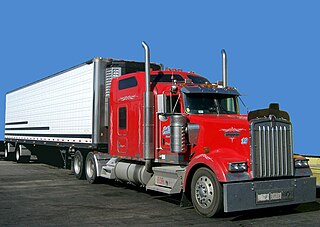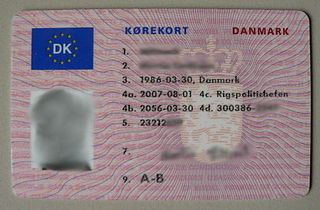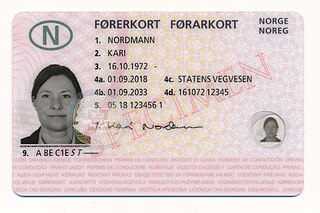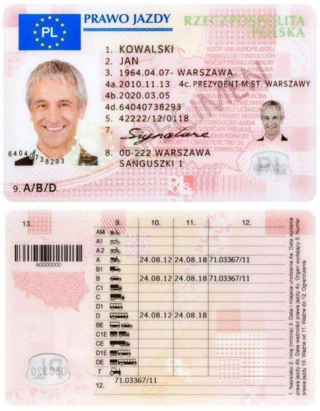An L-plate is a square plate bearing a sans-serif letter L, for learner, which must be affixed to the front and/or back of a vehicle in many countries if its driver is a learner under instruction, or a motorcycle rider with provisional entitlement to ride restricted motorcycles.

A commercial driver's license (CDL) is a driver's license required in the United States to operate large and heavy vehicles or a vehicle of any size that transports hazardous materials or more than 15 passengers.
Graduated driver licensing systems (GDLS) are designed to provide new drivers of motor vehicles with driving experience and skills gradually over time in low-risk environments. There are typically three steps or stages through which new drivers pass. They begin by acquiring a learner's permit, progress to a restricted, probationary or provisional license, followed by receipt of a full driver's license. Graduated drivers' licensing generally restricts nighttime, expressway, and unsupervised driving during initial stages, but lifts these restrictions with time and further testing of the individual, eventually concluding with the individual attaining a full driver's license.

Driver's education, driver education, driving education, driver's ed, driving tuition or driving lessons is a formal class or program that prepares a new driver to obtain a learner's permit or driver's license. The formal class program may also prepare existing license holders for an overseas license conversion or medical assessment driving test or refresher course. It may take place in a classroom, in a vehicle, online, or a combination of the above. Topics of instruction include traffic code or laws and vehicle operation. Typically, instruction will warn of dangerous conditions in driving such as road conditions, driver impairments, and hazardous weather. Instructional videos may also be shown, demonstrating proper driving strategies and the consequences for not observing the rules.
A driver's permit, learner's permit, learner's license or provisional license is a restricted license that is given to a person who is learning to drive, but has not yet satisfied the prerequisite to obtain a driver's license. Having a learner's permit for a certain length of time is usually one of the requirements for applying for a full driver's license. To get a learner's permit, one must typically pass a written permit test, take a basic competency test in the vehicle, or both.
The United Kingdom driving test is a test of competence that UK residents take in order to obtain a full Great Britain or Northern Ireland (car) driving licence or to add additional full entitlements to an existing one. Tests vary depending on the class of vehicle to be driven. In Great Britain it is administered by the Driver and Vehicle Standards Agency (DVSA) and in Northern Ireland by the Driver & Vehicle Agency (DVA).

In Canada, driver's licences are issued by the government of the province or territory in which the driver is residing. Thus, specific regulations relating to driver's licences vary province to province, though overall they are quite similar. All provinces have provisions allowing non-residents to use licences issued by other provinces and territories, out-of-country licences, and International Driving Permits. Many provinces also allow non-residents to use regular licences issued by other nations and countries. Canadian driver's licences are also valid in many other countries due to various international agreements and treaties.
In India, a driving licence is an official document that authorises its holder to operate various types of motor vehicles on highways and some other roads to which the public has access. In various Indian states, they are administered by the Regional Transport Authorities/Offices (RTA/RTO). A driving licence is required in India by any person driving a vehicle on any highway or other road defined in the Motor Vehicles Act, 1988. This act sets limits on the minimum age for vehicle operation ranging from 16 to 20, depending on specific circumstances. A modern photo of the driving licence can also serve many of the purposes of an identity card in non-driving contexts such as proof of identity or age.
The New Zealand driver licence system is a graduated system that has been in place since 1988. It consists of three phases for a car licence, each with varying levels of conditions.

Denmark does not use the C1 and D1 categories. This means a truck (C) or a bus (D) licence covers all trucks or buses, respectively, that are not covered by the car (B) licence. A B/E licence only allows heavy trailers on cars, even if the driver has a C or D permit.
In the Netherlands, a licence to drive a car can be obtained from the age of 17. However, the drivers must be supervised by an adult, who's at least 27 years old, until reaching the age of 18. If two serious offenses are committed within five years of a licence being issued to a new driver, the holder will have their licence revoked and must pass the test again to get their licence back.

Norwegian driving licences adhere to a standard set in the European Economic Area.

Swedish driving licences adhere to a standard set in the European Economic Area. 18 years is the minimum age to obtain a licence for cars.

In the United Kingdom, a driving licence is the official document which authorises its holder to operate motor vehicles on highways and other public roads. It is administered in England, Scotland and Wales by the Driver and Vehicle Licensing Agency (DVLA) and in Northern Ireland by the Driver & Vehicle Agency (DVA). A driving licence is required in England, Scotland, and Wales for any person driving a vehicle on any highway or other "road", as defined in s.192 Road Traffic Act 1988, irrespective of the ownership of the land over which the road passes. Similar requirements apply in Northern Ireland under the Road Traffic Order 1981.

Driving licences in Hong Kong are issued by the Transport Department. A full driving licence is valid for 10 years and is compulsory in order to drive a motor vehicle. Most driving licences are issued after the applicant passed a driving test for the respective type of vehicles. They may be issued without a test if the applicant is a holder of an overseas driving licence issued on passing a driving test in an approved country.

Driving licence in Thailand is a document that allows the holder to drive on any roads in Thailand and in other ASEAN states without an International Driving Permit. The minimum age to drive a motor vehicle is 18, and to drive a motorcycle is 15. Driving licence is issued and administered by the Department of Land Transport, Ministry of Transport and its branches, land transport offices across Thailand.

A driver's license is a legal authorization, or the official document confirming such an authorization, for a specific individual to operate one or more types of motorized vehicles—such as motorcycles, cars, trucks, or buses—on a public road. Such licenses are often plastic and the size of a credit card.

In Germany the driving licence ("Führerschein") is a governmental privilege given to those who request a licence for any of the categories they desire. It is required for every type of motorised vehicle with the exception of the smallest mopeds below 50cm³, with a speed limit of 25km/h, as well as motorised bicycles. The types of licences one may obtain are the same in all the European Economic Area. See European driving licence. The minimum age to obtain a driving licence is: 16 years for a restricted motorcycle up to 125 cm³, 17 years for a car with a legal guardian, 18 years for unrestricted car and 21 years for buses and cargo vehicles. However, in most German states, it is possible to get a license for a small motorcycle up to 50cm³ and limited to 45 km/h at the age of 15. Certain vintage East German motorcycles with top speeds of up to 60 km/h may be ridden with this type of license, making them especially popular with young riders.

In Spain, a driving licence is an official document which authorises the holder to operate motor vehicles. It is issued by the Directorate-General for Traffic (DGT).
In the Republic of Lebanon, a driving licence is the official document which authorises its holder to operate various types of motor vehicles on highways and some other roads to which the public have access and are issued by each individual district.













